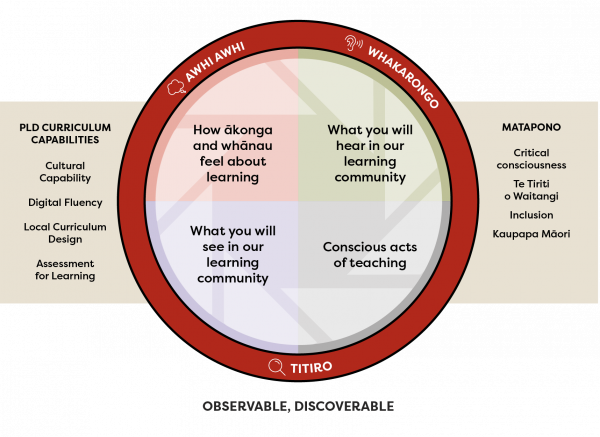Tuia te muka ako
Weaving the muka into learning contexts
Ngā hua o te mahi tahi | Collective impact 
If the PLD priorities are to make the difference that this kaupapa suggests then they need to impact on the moment-by-moment interactions that tamariki-mokopuna, kaiako, whānau, iwi, mana whenua, and community members have around learning. Our definition of a learning context is broad and takes in all learning environments.
The visual and table below focuses on the outcomes we seek in terms of the educational experiences of tamariki-mokopuna and whānau, and the conscious acts of teaching and leadership performed by educators. It imagines what tamariki-mokopuna and whānau might see, hear, or feel in a learning context and the conscious acts of teaching and school leadership an observer would witness and a kaiako or tumuaki might explain.
The visual and table weaves together the impact of the curriculum capabilities as they are understood through the framework of our kaupapa and ngā mātapono. It illustrates what we mean by effective teaching and learning across diverse learning contexts and foci, regardless of the PLD priority.
Kaiako, tumuaki, and manutaki can use the table to observe, discover, and pose questions about the teaching and learning happening within particular interactions, regardless of the nature of the PLD support that is being provided. It can be used and adapted in many ways:
- to inquire into the impact of PLD on kaiako, ākonga, and whānau
- as part of practitioner inquiry, to focus evaluative thinking and tools
- with ākonga as part of learning talk
- with whānau, iwi, mana whenua, and community partners as part of their contributions to learning
- to build a shared understanding across the community of what the capabilities look like in our school.
As you engage with the kaupapa and the joined-up capabilities described in this resource, your understandings about how the curriculum capabilities could play out in practice will evolve. It’s important that as a community of educators you explore examples from your own context to strengthen everyone’s capability to collectively impact on ākonga success as defined by your community.
Shared Lens over Learning |
|
 |
|
| Ākonga and whānau | Conscious acts of teaching |
|
Awhi awhi: How I feel
|
I am critically conscious about my teaching, so I ask myself and check with others about:
|
|
Titiro: What you will see in our learning community
|
I care about all of my ākonga, their progress and achievement, and their social and emotional success as culturally located learners, so you will see that I:
|
|
Whakarongo: What you will hear in our learning community
|
I care about my personal learning, growth, and development and that of my colleagues, so you will see that I:
|
Download a copy of Shared lens over learning
Good teachers, teachers who are helpful, they make the difference between me achieving and failing.
– Student in alternative education, cited in Education matters to me: Key insights.
There is compelling evidence of pedagogies that are highly effective for diverse (all) learners simultaneously. But such pedagogies have the potential to accelerate improvement only if they become part of teachers’ repertoires – and are informed by deep pedagogical understanding and adaptive expertise across schooling.
A coherent teaching programme is guided by a common set of principles and key ideas. These drive strategies for teaching and assessment and inform policies and procedures (relating, for example, to staff recruitment, evaluation, and professional development) that impinge on the teaching programme. High-quality programmes have high-quality content and a high degree of coherence.
– Robinson, V., Hohepa, M, & Lloyd, C., 2009
